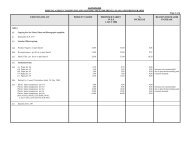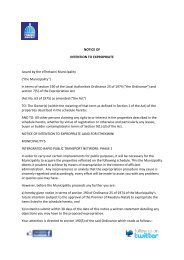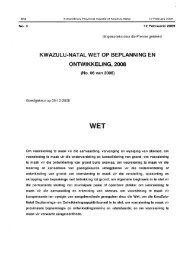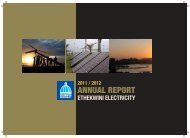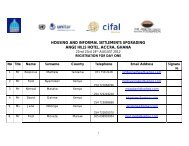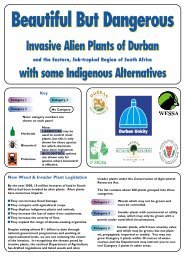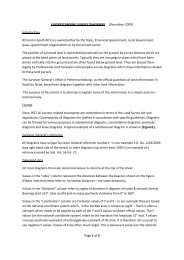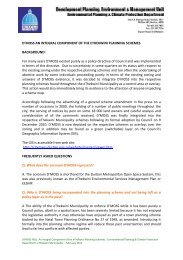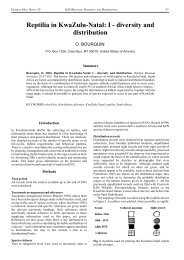Mullin, S. K., Taylor, P. J. & Pillay, N. 2004. Skull size and ... - Durban
Mullin, S. K., Taylor, P. J. & Pillay, N. 2004. Skull size and ... - Durban
Mullin, S. K., Taylor, P. J. & Pillay, N. 2004. Skull size and ... - Durban
Create successful ePaper yourself
Turn your PDF publications into a flip-book with our unique Google optimized e-Paper software.
MULLIN_08 13/08/04 12:45 Page 11<br />
Traditional measurements suggested the presence<br />
of 9 distinct phena in the CVA biplot (Fig. 2):<br />
MAMMALIA • 2004 • 68 (2)<br />
P R O O F<br />
D. foxi, D. nudipes, D. i. longipilosus, D. i. capensis,<br />
D. i. griseifrons, D. i. incomtus from the KwaZulu-<br />
Natal Province, D. i. incomtus from the Limpopo<br />
<strong>and</strong> Mpumalanga Provinces, material from Zimbabwe<br />
<strong>and</strong> material from the Okavango Delta.<br />
Only one of the Okavango Delta OTUs, Kasane-90,<br />
grouped with the Limpopo Province (South Africa)<br />
specimens, while the other four OTUs from this<br />
region were distinct on the second axis. Dasymys<br />
i. longipilosus from Mt Cameroon was distinct on<br />
the first axis <strong>and</strong> was clearly different from other<br />
material. The two Angolan OTUs representing<br />
D. incomtus grouped with east <strong>and</strong> central African<br />
OTUs. Dasymys foxi from Jos Plateau in Nigeria<br />
was on the periphery but outside the minimum<br />
African Dasymys systematics<br />
FIG. 3. – Plot of the first two variates of a multi-group canonical variates analysis of the dorsal skull partial warp matrix. The thin-plate<br />
splines (at a magnification factor of 10) depict dorsal skull deformations along the first <strong>and</strong> second variates. , West African D. rufulus;<br />
〈, D. foxi, π, Ethiopia <strong>and</strong> Sudan; , D. i. griseifrons; ?, Cameroon, Central African Republic, Congo, Democratic Republic of Congo;<br />
⊃, D. i. longipilosus; σ, East Africa; ∠, D. montanus; , Malawi, Mozambique <strong>and</strong> Tanzania; τ, D. incomtus from Angola; υ, D. nudipes;<br />
ρ, Okavango Delta; ≤, Zambia; , Zimbabwe; θ, Limpopo <strong>and</strong> Mpumalanga Provinces, South Africa; ϖ, KwaZulu-Natal Province,<br />
South Africa; ÷, D. i. capensis. OTUs (defined in Table 6.1) containing karyotyped individuals are demarcated by the diploid number.<br />
convex polygon enclosing other west African material,<br />
<strong>and</strong> was seen to be more similar to material<br />
from Zambia <strong>and</strong> Zimbabwe than to other west<br />
African individuals. Similarly, D. i. griseifrons from<br />
Lake Tana, Ethiopia was similar to other east<br />
African OTUs, but it appeared to be morphologically<br />
separate as it was outside the east Africa group.<br />
Two of the Zimbabwean OTUs (95-Mt Selinda,<br />
96-Matopos) fell within the KwaZulu-Natal<br />
Province (South Africa) group. The remainder of<br />
the OTUs (92-Nyamnetsi, 93-Harare, 94-Umtali)<br />
appeared to be morphologically similar to D. i.<br />
incomtus from the Limpopo Province as well as to<br />
Zambian material <strong>and</strong> one Mozambican OTU<br />
(85-Zambue). Finally, material from eastern,<br />
central <strong>and</strong> western Africa fell into one of three<br />
groups. East African OTUs separated from the<br />
11



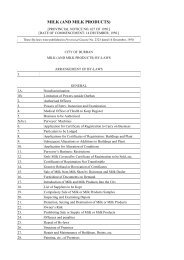
![INK Environmental Sustainability Booklet [19 MB] - Durban](https://img.yumpu.com/22025104/1/190x136/ink-environmental-sustainability-booklet-19-mb-durban.jpg?quality=85)

